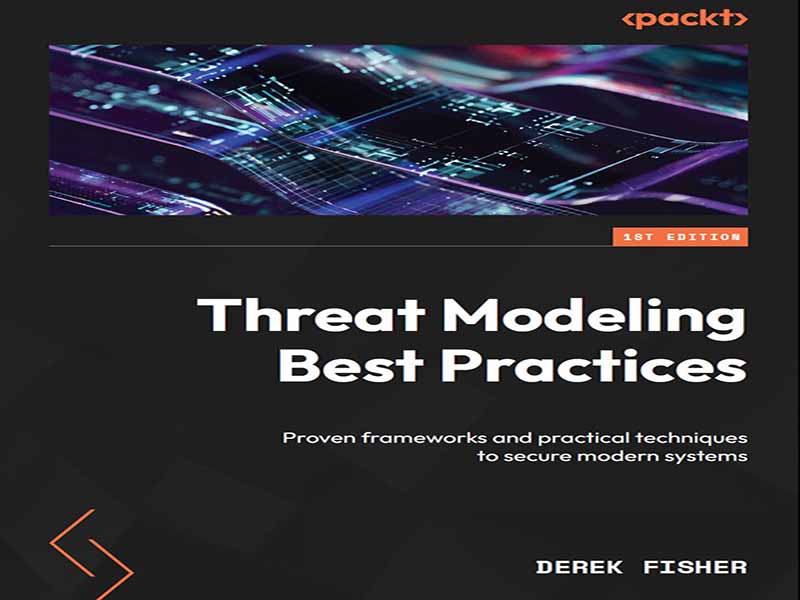- عنوان کتاب: Threat Modeling Best Practices -Proven frameworks and practical techniques to secure modern systems
- نویسنده: Derek Fisher
- حوزه: تهدیدات سایبری
- سال انتشار: 2025
- تعداد صفحه: 322
- زبان اصلی: انگلیسی
- نوع فایل: pdf
- حجم فایل: 8.55 مگابایت
مدلسازی تهدید شاید یکی از حیاتیترین و در عین حال کماستفادهترین شیوهها در امنیت سایبری مدرن باشد. همزمان با تغییر نحوهی انجام کسبوکار ما در هر صنعتی، سازمانها با گسترش بیسابقهای از سطوح حمله، از زیرساختهای سنتی درون سازمانی گرفته تا محیطهای پیچیدهی چند ابری، اکوسیستمهای اینترنت اشیا به هم پیوسته و برنامههای کاربردی مبتنی بر هوش مصنوعی که به طور فزایندهای پیچیده میشوند، مواجه هستند. رویکرد واکنشی برای رسیدگی به آسیبپذیریهای امنیتی پس از کشف یا بهرهبرداری از آنها، دیگر کافی نیست، زیرا تهدیدات سایبری بخشی از زندگی روزمره هستند و هزینهی نقضهای امنیتی همچنان در حال افزایش است. در اصل، مدلسازی تهدید یک رویکرد ساختاریافته برای شناسایی، درک و رسیدگی به تهدیدات امنیتی بالقوه قبل از بهرهبرداری از آنهاست. این امر به تیمهای امنیتی اجازه میدهد تا از اقدامات امنیتی واکنشی فاصله بگیرند و در عوض تلاش کنند تا شیوههای مدیریت ریسک پیشگیرانه را ایجاد کنند. این امر با انجام تجزیه و تحلیل سیستماتیک معماریهای سیستم، جریان دادهها، مرزهای اعتماد و بردارهای حملهی بالقوه توسط تیمهای امنیتی رخ میدهد و به آنها بینش میدهد تا تلاشهای خود را اولویتبندی کرده و منابع را به طور مؤثر تخصیص دهند. آنچه جذاب بوده است، تغییرات در مدلسازی تهدید در طول سالها است. آنچه که به عنوان یک رشته تخصصی در ابتدا به چند متخصص ارشد امنیت و آزمایشکنندگان نفوذ واگذار شده بود، اکنون به بخش وسیعتری از شیوههای توسعه امن تبدیل شده و در معرض منابع بیشتری قرار دارد، که بخشی از آن به دلیل در دسترس بودن ابزارهای قابل دسترستر و شهودیتر است. این کتاب شما را با طیف وسیعی از فرآیندها و شیوههای مدلسازی تهدید آشنا میکند. از روشهای بنیادی مانند STRIDE گرفته تا پیادهسازیهای پیشرفته که با سرعت توسعه سیستم همگام هستند، ما با ایجاد درک کاملی از اصول، روشها و بهترین شیوههای مدلسازی تهدید که پایه و اساس شناسایی تهدید را تشکیل میدهند، شروع میکنیم. سپس از طریق کاربردهای عملی در چرخههای توسعه نرمافزار، جایی که مدلسازی تهدید به بخش جداییناپذیری از شیوههای کدنویسی امن و گردشهای کاری DevSecOps تبدیل میشود، پیشرفت میکنیم. این کتاب چالشها و فرصتهای منحصر به فرد ارائه شده توسط محیطهای ابری و زیرساختی را بررسی میکند، جایی که مرزهای امنیتی سنتی از بین رفته و پارادایمهای جدیدی مانند معماریهای اعتماد صفر ضروری شدهاند. ما به امنیت زنجیره تأمین، که با افزایش ارتباط و وابستگی سازمانها به فروشندگان و خدمات شخص ثالث، به یک نگرانی فزاینده تبدیل شده است، خواهیم پرداخت. انقلاب موبایل و اینترنت اشیا چالشهای خاص خود را به همراه دارد و نیازمند روشهای مختلف تفکر در مورد مدلسازی تهدید است که محدودیتهای منابع، پروتکلهای ارتباطی متنوع و استقرار در مقیاس گسترده را در نظر میگیرد. یکی از هیجانانگیزترین و چالشبرانگیزترین مرزهای مدلسازی تهدید امروزه، کاربرد (و استفاده) از این روشها در سیستمهای هوش مصنوعی و یادگیری ماشین است. با رواج بیشتر هوش مصنوعی در برنامههای کاربردی حیاتی کسب و کار، درک و کاهش خطراتی مانند حملات خصمانه، مسمومیت دادهها، سرقت مدل و تزریق سریع، حیاتی میشود. این کتاب راهنماییهای عملی برای گسترش چارچوبهای سنتی مدلسازی تهدید برای رسیدگی به این تهدیدهای نوظهور مختص هوش مصنوعی ارائه میدهد. فراتر از کاربردهای فنی، ما به جنبههای سازمانی مدلسازی تهدید میپردازیم و راهنماییهایی در مورد ایجاد و حفظ شیوههای مؤثر مدلسازی تهدید در یک سازمان ارائه میدهیم. این شامل تشکیل تیم، انتخاب ابزار، ادغام فرآیند، توسعه معیارها و ایجاد یک جامعه عملی مدلسازی تهدید است. در سراسر این کتاب، مطالعات موردی دنیای واقعی از سازمانها نشان میدهد که چگونه اصول مدلسازی تهدید به بهبودهای امنیتی عملی و ارزش تجاری تبدیل میشود. این مثالها نه تنها جنبههای فنی مدلسازی تهدید، بلکه تعهد سازمانی و تغییرات فرهنگی مورد نیاز برای اجرای موفقیتآمیز را نیز نشان میدهند.
Threat modeling is perhaps one of the most critical yet underutilized practices in modern cybersecurity. As technology transforms the way we do business across every industry, organizations face an unprecedented expansion of their attack surfaces, from traditional on-premises infrastructure to complex multi-cloud environments, interconnected IoT ecosystems, and increasingly sophisticated AI-powered applications. The reactive approach of addressing security vulnerabilities after they are discovered or exploited is no longer sufficient when cyber threats are a part of daily life and the cost of security breaches continues to increase. At its core, threat modeling is a structured approach to identifying, understanding, and addressing potential security threats before they can be exploited. It allows security teams to step away from reactive security measures and instead attempt to build proactive risk management practices. This occurs with the security teams performing systematic analysis of system architectures, data flows, trust boundaries, and potential attack vectors, giving them insights to prioritize their efforts and allocate resources effectively. What has been fascinating is the changes in threat modeling over the years. What began as a specialized discipline primarily left to a few senior security specialists and penetration testers has now become a broader part of secure development practices and is exposed to a larger bench of resources, thanks in part to the availability of more approachable and intuitive tools. This book takes you through the spectrum of threat modeling processes and practices. From foundational methodologies such as STRIDE to cutting-edge implementations that keep pace with the speed of system development, we begin by establishing a solid understanding of threat modeling principles, methodologies, and best practices that form the foundation of threat identification. We then progress through practical applications across software development lifecycles, where threat modeling becomes an integral part of secure coding practices and DevSecOps workflows. The book explores the unique challenges and opportunities presented by cloud and infrastructure environments, where traditional security boundaries have dissolved and new paradigms such as zero-trust architectures have become essential. We will delve into supply chain security, an increasingly critical concern as organizations become more interconnected and dependent on third-party vendors and services. The mobile and IoT revolution brings its own set of challenges, requiring different ways of thinking about threat modeling that account for resource constraints, diverse communication protocols, and massive scale deployments. One of the most exciting and challenging frontiers in threat modeling today is the application (and usage) of these methodologies to artificial intelligence and machine learning systems. As AI becomes more prevalent in critical business applications, understanding and mitigating risks such as adversarial attacks, data poisoning, model theft, and prompt injection becomes critical. This book provides practical guidance for extending traditional threat modeling frameworks to address these emerging AI-specific threats. Beyond technical applications, we address the organizational aspects of threat modeling, providing guidance on building and sustaining effective threat modeling practices within an organization. This includes team formation, tool selection, process integration, metrics development, and the creation of a threat modeling community of practice. Throughout this book, real-world case studies from organizations illustrate how threat modeling principles translate into practical security improvements and business value. These examples demonstrate not only the technical aspects of threat modeling but also the organizational commitment and cultural changes required for successful implementation.
این کتاب را میتوانید از لینک زیر بصورت رایگان دانلود کنید:
Download: Threat Modeling Best Practices




































نظرات کاربران